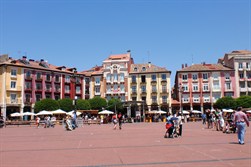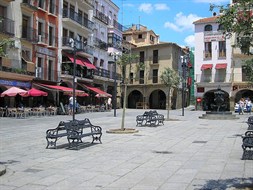Other examples: Burgos and Plasencia
 Among the Spanish plazas mayores built or remodeled in the Baroque period, the Plaza Mayor of Burgos is worthy of note. Over the centuries, it has often changed its name, in relation to the historical events that have affected the city, but its role as the seat of the weekly market, a short walk from the city walls, is attested as early as the late Middle Ages. In the Early Modern period, it also became the scene of ceremonies and public celebrations, as well as numerous bullfights. Philip IV (1605-1665) attended one of these in 1660. Starting from 1791, however, the square underwent radical reform, after which it became the seat of the municipal government but lost its role as the main city market in favor of the Plaza del Mercado Mayor (and for this reason it was also called the Plaza del Mercado Menor). A few years earlier, in 1784, the great statue of Charles III was inaugurated. During the twentieth century, the square has undergone significant changes, but losing the symmetry that characterizes the other plazas mayores in Spain. Its irregular shape and the difference with buildings that surround it, both in regard to structure and in height attest to its specificity.
Among the Spanish plazas mayores built or remodeled in the Baroque period, the Plaza Mayor of Burgos is worthy of note. Over the centuries, it has often changed its name, in relation to the historical events that have affected the city, but its role as the seat of the weekly market, a short walk from the city walls, is attested as early as the late Middle Ages. In the Early Modern period, it also became the scene of ceremonies and public celebrations, as well as numerous bullfights. Philip IV (1605-1665) attended one of these in 1660. Starting from 1791, however, the square underwent radical reform, after which it became the seat of the municipal government but lost its role as the main city market in favor of the Plaza del Mercado Mayor (and for this reason it was also called the Plaza del Mercado Menor). A few years earlier, in 1784, the great statue of Charles III was inaugurated. During the twentieth century, the square has undergone significant changes, but losing the symmetry that characterizes the other plazas mayores in Spain. Its irregular shape and the difference with buildings that surround it, both in regard to structure and in height attest to its specificity.
 Even the Plaza Mayor of Plasencia has features which are common to many other Iberian squares: it was in fact home to both the weekly market of the city, already in the latter part of the Middle Ages and to the municipal government. To the side of the municipal building, dating back to the sixteenth century, is the old jail, which dates from the seventeenth century as is evinced in the coat of arms of King Philip IV. Unlike most Spanish plazas mayores, Plasencia’s is not located outside the old city, but in the middle of it.
Even the Plaza Mayor of Plasencia has features which are common to many other Iberian squares: it was in fact home to both the weekly market of the city, already in the latter part of the Middle Ages and to the municipal government. To the side of the municipal building, dating back to the sixteenth century, is the old jail, which dates from the seventeenth century as is evinced in the coat of arms of King Philip IV. Unlike most Spanish plazas mayores, Plasencia’s is not located outside the old city, but in the middle of it.
